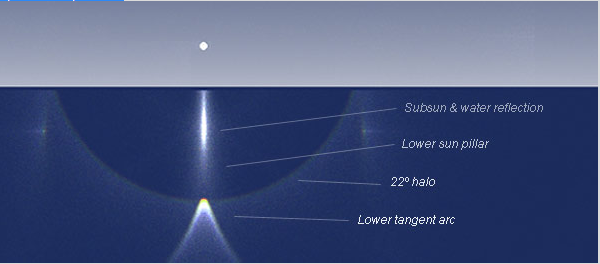Tangent arc gallery
Tangent Arc Gallery: A Phenomenal Display of Atmospheric Optics
Atmospheric optics never fails to amaze us with its stunning displays of natural phenomena. One such captivating spectacle is the tangent arc, a subtle but beautiful optical effect that occurs when the sun is low on the horizon. In this article, we will delve deeper into the tangent arc gallery, exploring its characteristics, formation, and where it can be observed.
The Enigmatic Lower Tangent Arc
The lower tangent arc is an elusive feature that often remains hidden below the horizon. However, it can be witnessed from elevated vantage points such as hills or mountains, provided there are clouds or cold air below containing the necessary ice crystals. This combination creates the perfect conditions for the lower tangent arc to manifest its glory.
Captivating Sightings in Girdwood, Alaska
Ryan Skorecki, a keen observer of atmospheric optics, was fortunate enough to capture these rare arcs in Girdwood, Alaska. His photographs showcase the ethereal beauty of the lower tangent arc, providing us with a glimpse of its enchanting allure. We are grateful to Ryan Skorecki for granting us permission to reproduce his mesmerizing images.
HaloSim Simulation Unveils the Magic
To gain a deeper understanding of the tangent arc phenomenon, we turn to HaloSim simulations. By simulating a solar altitude of 6º, we can observe how this specific angle affects the appearance of the tangent arc and other associated halos. The simulations reveal that the bright subsun and a portion of the lower sun pillar in the image were partly produced by reflections from the water or ice of Turnagain Arm, deep within the valley.
Exploring the Formation of Tangent Arcs
Tangent arcs are formed through the interaction of sunlight with hexagonal ice crystals present in the atmosphere. These ice crystals act as prisms, refracting and reflecting sunlight in intricate ways, ultimately giving rise to the tangent arc phenomenon. As sunlight enters the ice crystals, it undergoes refraction, bending its path and separating it into its component colors. This dispersion creates a stunning display of colors in the sky.
The Unique Characteristics of Tangent Arcs
Tangent arcs possess distinctive features that set them apart from other atmospheric optical phenomena. Here are some notable characteristics of these captivating arcs:
- Tangent arcs appear as partial circles or arcs, tangentially touching the 22º halo.
- They often exhibit a fainter intensity compared to other halos, lending them an air of subtlety and mystique.
- The colors observed in tangent arcs are typically pale and delicate, ranging from pink and violet to blue and green.
Where to Witness the Tangent Arc Gallery
To witness the mesmerizing tangent arc gallery, one must be in the right place at the right time. Here are a few key factors that increase the likelihood of observing this awe-inspiring phenomenon:
- The sun must be low on the horizon, preferably below 10º.
- Elevated vantage points, such as hills or mountains, provide a better chance of spotting the lower tangent arc.
- The presence of clouds or cold air containing ice crystals is crucial for the formation of tangent arcs.
Seeking Inspiration from Nature's Canvas
The tangent arc gallery serves as a testament to the breathtaking beauty and complexity of atmospheric optics. It reminds us of the wonders that surround us, often hidden in plain sight. By immersing ourselves in these natural phenomena, we gain a deeper appreciation for the intricate workings of our atmosphere and the stunning visual displays it can produce.
Conclusion
The tangent arc gallery is a captivating display of atmospheric optics that showcases the interplay between sunlight and ice crystals in the atmosphere. While elusive and subtle, these arcs possess a unique beauty that is worth seeking out. Whether observing them from elevated vantage points or through simulations, the tangent arc phenomenon continues to fascinate and inspire, reminding us of the enchanting marvels that exist within our natural world.

Lower tangent arc and other halos. When the sun is low the horizon hides the lower tangent arc but it can be seen from from hills or mountains when there are clouds or cold air below containing the necessary ice crystals. Ryan Skorecki (site) caught these arcs at Girdwood Alaska. ©Ryan Skorecki, reproduced with permission.

The HaloSim simulation for a solar altitude of 6º. The bright subsun and part of the lower sun pillar in the image were partly produced by reflection from the water or ice of Turnagain Arm deep in the valley
Note: this article has been automatically converted from the old site and may not appear as intended. You can find the original article here.
Reference Atmospheric Optics
If you use any of the definitions, information, or data presented on Atmospheric Optics, please copy the link or reference below to properly credit us as the reference source. Thank you!
-
<a href="https://atoptics.co.uk/blog/tangent-arc-gallery/">Tangent arc gallery</a>
-
"Tangent arc gallery". Atmospheric Optics. Accessed on December 23, 2024. https://atoptics.co.uk/blog/tangent-arc-gallery/.
-
"Tangent arc gallery". Atmospheric Optics, https://atoptics.co.uk/blog/tangent-arc-gallery/. Accessed 23 December, 2024
-
Tangent arc gallery. Atmospheric Optics. Retrieved from https://atoptics.co.uk/blog/tangent-arc-gallery/.